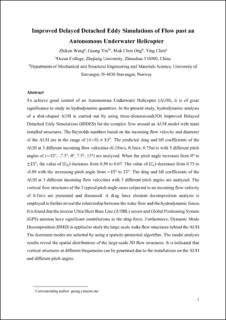| dc.contributor.author | Wang, Zhikun | |
| dc.contributor.author | Yin, Guang | |
| dc.contributor.author | Ong, Muk Chen | |
| dc.contributor.author | Chen, Ying | |
| dc.date.accessioned | 2024-03-05T12:06:47Z | |
| dc.date.available | 2024-03-05T12:06:47Z | |
| dc.date.created | 2023-09-26T10:04:25Z | |
| dc.date.issued | 2023 | |
| dc.identifier.citation | Wang, Z., Yin, G., Ong, M. C., & Chen, Y. (2023). Improved delayed detached eddy simulations of flow past an autonomous underwater helicopter. Physics of Fluids, 35(7). | en_US |
| dc.identifier.issn | 1070-6631 | |
| dc.identifier.uri | https://hdl.handle.net/11250/3121088 | |
| dc.description.abstract | To achieve good control of an autonomous underwater helicopter (AUH), it is of great significance to study its hydrodynamic quantities. In the present study, hydrodynamic analysis of a disk-shaped AUH is carried out by using three-dimensional (3D) improved delayed detached eddy simulations for the complex flow around an AUH model with main installed structures. The Reynolds numbers based on the incoming flow velocity and diameter of the AUH are in the range of (4-8) x 105. The predicted drag and lift coefficients of the AUH at three different incoming flow velocities (0.35, 0.5, and 0.75 m/s) with five different pitch angles of (-15 degrees, -7.5 degrees, 0 degrees, 7.5 degrees, and 15 degrees) are analyzed. When the pitch angle increases from 0 degrees to 615 degrees, the value of (CD) increases from 0.50 to 0.67. The value of (CL) decreases from 0.73 to -0.89 with the increasing pitch angle from -15 degrees to 15 degrees. The drag and lift coefficients of the AUH at three different incoming flow velocities with five different pitch angles are analyzed. The vortical flow structures of the three typical pitch angle cases subjected to an incoming flow velocity of 0.5 m/s are presented and discussed. A drag force element decomposition analysis is employed to further reveal the relationship between the wake flow and the hydrodynamic forces. It is found that the inverse ultrashort base line sensor and global positioning system antenna have significant contributions to the drag force. Furthermore, dynamic mode decomposition is applied to study the large-scale wake flow structures behind the AUH. The dominant modes are selected by using a sparsity-promoted algorithm. The modal analysis results reveal the spatial distributions of the large-scale 3D flow structures. It is indicated that vortical structures at different frequencies can be generated due to the installations on the AUH and different pitch angles. | en_US |
| dc.language.iso | eng | en_US |
| dc.publisher | AIP Publishing | en_US |
| dc.title | Improved delayed detached eddy simulations of flow past an autonomous underwater helicopter | en_US |
| dc.type | Peer reviewed | en_US |
| dc.type | Journal article | en_US |
| dc.description.version | acceptedVersion | en_US |
| dc.rights.holder | The authors | en_US |
| dc.subject.nsi | VDP::Teknologi: 500 | en_US |
| dc.source.volume | 35 | en_US |
| dc.source.journal | Physics of Fluids | en_US |
| dc.source.issue | 7 | en_US |
| dc.identifier.doi | 10.1063/5.0155820 | |
| dc.identifier.cristin | 2178847 | |
| cristin.ispublished | true | |
| cristin.fulltext | postprint | |
| cristin.qualitycode | 2 | |
